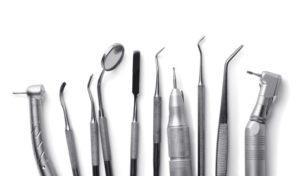
Some people keep their eyes closed at the dentist. Others stare at the ceiling or watch tv. No matter if you’re visiting your dentist for a routine checkup or much-needed restorative care, you might be curious about the tools being used for your oral care since you probably haven’t gotten a great look at them.
After all, it’s your mouth – you should probably know what’s going on in there. When you consider the key instrument for tooth extraction in the 1300s was called a “dental pelican,” you can thank your lucky stars about having access to modern dental technology.
Here’s a brief guide of basic dental instruments and what they are used for:
MOUTH MIRROR
This small mirror attached to a metal stick allows the dentist to view places in the mouth easily and find potential problems that would otherwise go undetected. It also gives the dentist an easy way to move your tongue or push on the inside of your cheek.
SICKLE PROBE
Also known as a dental explorer, this tool is beneficial in finding signs of cavities or gum disease. This instrument has a long handle with a sharp-looking hook on the end. This is primarily used to explore the pockets between teeth, while also scraping away tarter and plaque.
SCALER
The previous tool is ideal for removing small areas of plaque and tarter, but this one is more essential for the removal of greater buildup. Most patients requiring this tool have significant issues with gum disease. While brushing and flossing remove most plaque formed after you eat or drink, additional removal is sometimes required. A scaler can prevent you from losing your teeth to decay.
SALIVA EJECTOR
This tool’s purpose is to create a dry surface in your mouth. A long tube is attached to a vacuum that removes your saliva. You may hear some vacuum sounds and feel the ejector stick to your cheek or tongue, but it’s no cause for alarm.
DENTAL DRILL
Spinning at more than 250,000 RPMs while shooting water into your mouth, this tool is the most effective way to remove tooth decay before filling a cavity. Without administering water, the drill would get hot enough to damage the tooth.
DENTAL SYRINGE
This delivers the numbing shot to your mouth. It’s a bit longer than a typical needle or syringe so the dentist can hit the precise spot when administering the anesthetic. Many dentists also administer a topical anesthetic prior to using the syringe.
MOLDS
If you need a crown, cap, or mouthguard, your dentist may need to get a mold of your teeth. They are small frames filled with a soft substance and placed in your mouth so you can bite down. Some dentists offer flavored versions.
Now that you know more about the tools your dentist is using, there is nothing to fear. Plus, you might impress them by sharing how much you know about each instrument!
ABOUT THE PRACTICE
Dr. Aaronson & Associates has been practicing in the same Manhattan location for more than 45 years, and our talented staff looks forward to providing you and your family with the absolute best in oral healthcare. Dr. Aaronson has forged a true team of experts who can provide a comprehensive list of dental services. He has been honored in the Guide to America’s Top Dentists, as well as America’s Cosmetic Doctors and Dentists. To schedule a checkup and get a closer look at these dental tools you’ve learned more about, or to get more info on one of the many other dental services offered, visit our website or call (917) 722-6573.
